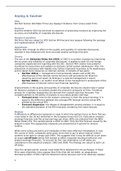Samenvatting
Summary Advanced Accounting Information Systems - Articles
This is an English, 6-page summary of the articles that you have to study for the exam of Advanced Accounting Information Systems. I attended the lecture and summarized the most important points for each article. The summary contains everything you need to know for the exam about the five articles....
[Meer zien]




